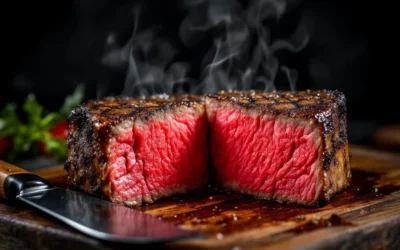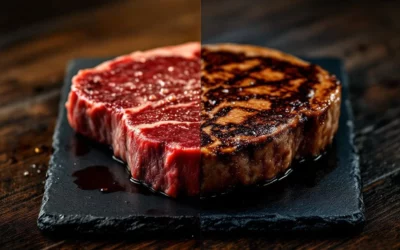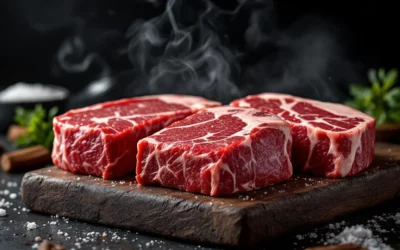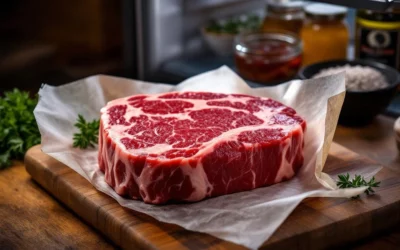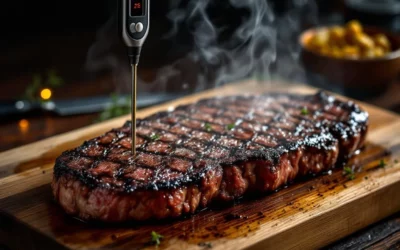You can prevent a tough steak by cooking at the right temperature, not overcooking it, and letting the meat rest after preparation. The most important factors are a hot pan (180-220°C), the correct cooking time per thickness (2-4 minutes per side for medium-rare), and choosing tender cuts such as ribeye or entrecôte. By bringing the meat to room temperature beforehand and letting it rest for 5-10 minutes after cooking, you preserve the juiciness and tenderness. A steak becomes tough when the proteins in the meat are heated too quickly or for too long. At temperatures above 70°C, they contract […]

Steakhouse Experience Amsterdam
Laatste blogposts
What exactly do the different degrees of doneness mean?
The different degrees of doneness for meat determine the texture, flavor, and juiciness of your steak. There are five standard degrees of doneness: rare (49-52°C), medium-rare (52-55°C), medium (55-60°C), medium-well (60-65°C), and well done (65°C+). Each degree of doneness has its own characteristics, from a red, tender center in rare to completely cooked through in well done. The right choice depends on personal preference and the type of meat you order. Degrees of doneness are temperature levels that determine how thoroughly your meat is cooked. These degrees are standardized worldwide in steakhouses and ensure that you get exactly what you order. The five main degrees of doneness are rare, medium-rare, medium, […]
How long should you let your steak rest after grilling?
A perfectly cooked steak must rest for at least 5 minutes after grilling before you cut into it. For thicker steaks that are 3-4 cm thick, allow approximately 10 minutes of resting time. This resting period ensures that the meat juices distribute evenly throughout the steak, making it more succulent and tender. It’s a simple step that makes the difference between a good steak and an exceptional one. During grilling, the heat forces the meat juices toward the center of your steak. If you cut into your steak immediately after cooking, all these precious juices will run out onto your plate. By […]
What is the difference between wet-aged and dry-aged meat?
The difference between wet-aged and dry-aged meat lies primarily in the aging method, flavor, and texture. In wet-aging, the meat ages in vacuum packaging where moisture is retained, resulting in a mild meat flavor. Dry-aged meat, on the other hand, hangs in a controlled environment where moisture evaporates, giving you an intense, nutty flavor with more complex aromas. The aging of meat is a natural process where enzymes make the meat more tender by breaking down protein structures. This occurs after the animal is slaughtered and the meat is given time to rest. During this period, the muscle fibers change and the meat becomes […]
What influence does the breed of cattle have on the taste?
The breed of cattle has a significant influence on the flavor of meat through differences in genetics, muscle structure, and fat marbling. Each breed develops unique flavor characteristics through centuries of selection and adaptation to specific environments. From the buttery-rich Wagyu to the lean Limousin, the natural properties of the breed determine the texture, juiciness, and flavor intensity of the meat. These biological factors work together to create the distinctive flavor profiles that you taste on your plate. The flavor of beef is fundamentally determined by the genetic characteristics of the breed. Just as different grape varieties produce unique wines, each cattle breed has its […]
How do you best store raw steak in the refrigerator?
Raw steak is best stored in the refrigerator at a temperature between 0 and 4 degrees Celsius, on the bottom shelf in its original packaging or well wrapped in plastic wrap. Place the meat on a plate to prevent leaking and use it within 3-5 days for optimal freshness. For longer storage, you can freeze steak, but this may affect the texture. The ideal temperature for storing raw steak is between 0 and 4 degrees Celsius. This temperature prevents bacterial growth and keeps your meat fresh without freezing it. Most modern refrigerators have different temperature zones, where […]
What is marbling and why is it important for flavor?
Marbling is the network of white fat veins that you see running through red meat, especially in beef. This intramuscular fat melts during cooking and provides a richer flavor, more juiciness, and a tender texture. The more marbling present, the more intense the flavor experience becomes. The best marbling can be found in breeds such as Wagyu and Aberdeen Angus, where the fat is evenly distributed throughout the meat. Marbling consists of the fine white fat lines that you see running through the red meat, creating a marble-like pattern. This is intramuscular fat, which means that the fat is located within the muscle fibers. This […]
What temperature should you maintain for different degrees of doneness?
For perfectly cooking meat, the correct core temperature is important. Each degree of doneness has its own temperature range: rare (49-52°C), medium-rare (54-57°C), medium (58-63°C), medium-well (64-68°C) and well-done (69°C+). With a good meat thermometer, you measure the temperature in the thickest part of the meat, and don’t forget that the temperature will still rise 3-5 degrees during resting. There are five classic degrees of doneness, each with their own characteristic properties. Rare meat has a cool, red center with a soft texture and maximum juiciness. The meat feels tender and has a deep red color inside. Medium-rare is the most popular choice for […]

Arnhem
Vlees & Co Arnhem
Nieuwe Plein 22a
6811 KR Arnhem
026 70 24 010
arnhem@vleesenco.nl
Nijmegen
Vlees & Co Nijmegen
Kelfkensbos 32
6511 TB Nijmegen
024 20 68 973
nijmegen@vleesenco.nl
Amsterdam
Vlees & Co Amsterdam
Albert Molhof 1
1031 JK Amsterdam
020 786 89 22
amsterdam@vleesenco.nl

